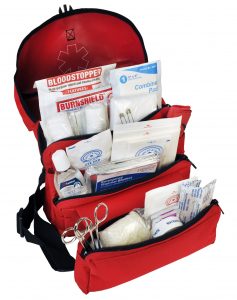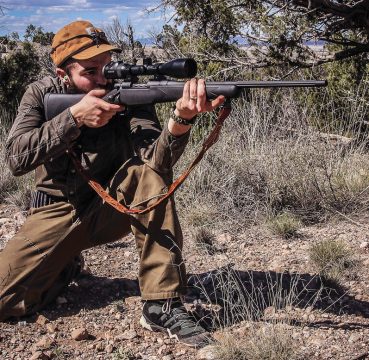Table Of Contents
- You’re Carrying A Loaded Firearm…Don’t Forget It
- Use Quality Ammunition
- Sight In Your Rifle First
- Wear Appropriate Clothing
- Don’t Carry Your Kill Over Your Shoulder
- Clearly Spot the Animal Before You Shoot
- Wear Orange
- Pack A First Aid Kit
- Carry Survival Items With You
- Make Navigation A Priority
- Conclusion
- Recommended Reading
Now that hunting season is in full swing, it would probably be a good time to go over some crucial hunting safety tips that you will want to apply when you are out hiking around with your rifle in the woods (or wherever else you are).
Many hunting accidents have been caused out in the woods and mountains of the United States, and many of those accidents could have easily been avoided had the hunters involved in them simply taken some basic safety precautions.
Here are the top hunting safety tips that you need to follow:
You’re Carrying A Loaded Firearm…Don’t Forget It
Contrary to what some people may tell you, it’s not a good idea to go hunting with a gun that’s unloaded or not chambered. The reason why is because you may need to quickly raise the rifle to take a shoot, such as if a spooked deer suddenly bursts out of the brush and takes off running. Having to work the bolt, lever, or the action to get the rifle chambered will just be a waste of time. Instead, it would be much more efficient to flick the safety off, bring the butt of the stock to your shoulder, aim, and take the shot.

Of course, there are many simply gun safety precautions that you will want to take into account when packing a loaded firearm of any kind around. You need to be fully aware of where the muzzle is pointing at all times, especially if you are hunting with other people in the area. You can keep the rifle slung over your shoulder with the barrel pointing up towards the sky, or you can hold it in your hands and keep the barrel pointed towards the ground.
Also, if the rifle you are packing comes with a safety, keep the safety engaged throughout the hunt and only flick it off when you spot an animal you want to shoot. Also, don’t walk around the woods with your finger resting over the trigger of the firearm.
Use Quality Ammunition
Never use old ammo that has been corroded or discolored in any way in your hunting firearm. Not only can it through off performance, it could also potentially cause major safety issues in the gun itself (do you really want your rifle to blow up in your arms when you shoot it?).
Also, you need to be very specific about the exact make, model, and weight of bullets that you are using. The specific ammunition that you use to sight in your rifle at the range and confirm that it’s performing well in your rifle. Don’t just grab another random box off the shelf to use for hunting. Instead, use ammo that you know works well and that is preferably designed for hunting as well.
Speaking of sighting in…
Sight In Your Rifle First
Regardless of whether you are going to be shooting with open sights or with an optic, you are going to need to sight in your rifle. This isn’t a waste of time: it’s necessary to confirm hat your rifle is accurate so you can
Wear Appropriate Clothing

The number one best piece of advice to follow in regards to dressing while hunting will be to dress in layers and then to add or take away layers as you see fit. Have a base layer of the clothing that is in direct contact with your skin, an insulation layer to keep you warm, and then an outer shell layer for resisting wind, rain, and moisture. As you travel and begin to sweat, you can remove certain layers to help you cool down.
Be strategic about the materials for clothes you choose to wear too. Merino wool will be an excellent choice for a hunting coat because it can keep you warm and do a good job for resisting moisture; alternative materials such as cotton may keep you warm, but they do a terrible job of resisting water and sweat and can even cause you to freeze if you are not too careful. Furthermore, wool is breathable, does not stretch, and is not very itchy.
Don’t Carry Your Kill Over Your Shoulder
When you do shoot an animal, such as a deer, the last thing you want to do is haul it back to camp or your truck by lifting it over your shoulder?
Why?
Simple: there may be another hunter in the woods who, through the trees and thick brushes, spots the hide of a deer moving along and quickly takes aim with his rifle. Little does he know, the deer is really already dead…because it’s being carried over your shoulder.
Instead, the best way to carry a deer or kill back to your camp or to your truck will be to lash paracord or rope around its ankles near the hooves, and then carry it back that way. Alternatively, such as if you’re out elk hunting, you can quarter the animal into smaller pieces and carry it out that way (this process will be greatly sped up if you are with other people).
Clearly Spot the Animal Before You Shoot
Keeping the above scenario in mind: you should always clearly spot the animal before you take the shot. Never open fire when you do not have any kind of visual confirmation. Simply hearing rustling in the brush is never suitable justification for firing your weapon.
All the same, simply seeing a glimpse or portion of the animal is not good enough either. You need to see the entire animal in clear view, and confirm that there are absolutely no people in its vicinity.
Wear Orange
It’s probably the most cliched hunting safety tip out there, but wearing orange really can help other hunters clearly identify you (so they won’t misidentify you for an animal or anything else). Even simply wearing an orange hat would be better than nothing at all.
Pack A First Aid Kit

Carrying a first aid kit in your hunting back will be absolutely necessary for hopefully obvious reasons: if you sustain an injury out in the woods where you are alone and without access to professional medical assistance, you will be on your own until you can find help.
You will need to buy a complete first aid kit and fully familiarize yourself with its contents. Don’t just buy a kit and then throw it in your hunting back without you actually looking through it and knowing what’s in there (and learning how to use the items as well.
At the bare minimum, your hunting first aid kit should include a tourniquet, gauze pads and bandages of varying sizes, medical tape, scissors, tweezers, antibiotic ointment, and a splint.
Carry Survival Items With You
In addition to packing a first aid kit with you at all times, you are going to need a complete survival kit as well. In the event that you get lost or injured and therefore stranded out in the woods, a basic survival kit can be what keeps you alive until rescue comes.
At the bare minimum, your survival kit should consist of a knife, extra socks, at least two fire starting devices (matches and a flint striker would be good), a poncho, tarp of some kind that you can use for shelter, water purification tablets and filter, gloves, flashlight with spare batteries, whistle, bandana, and food (protein bars or candy, both of which are easily portable, would be good).
One of your top priorities when hunting out in the woods should be navigation – AKA, making sure that you don’t get lost!
In fact, this is more important than locating an animal to shoot. Ideally, you can scout out the area before you hunt it. Have a map of the area and compass, along with a high quality GPS device (Garmin makes the best ones).
Use visual indicators and natural landmarks as you walk to ensure that you don’t get lost, and retain your sense of direction. You’re in trouble if you can’t remember which direction your truck or campsite is.
Conclusion
Following the above safety tips will simply help ensure an overall safer hunt the next time you go out. You would also be wise to pass on the above tips to people who will be going with you in your group as well.











